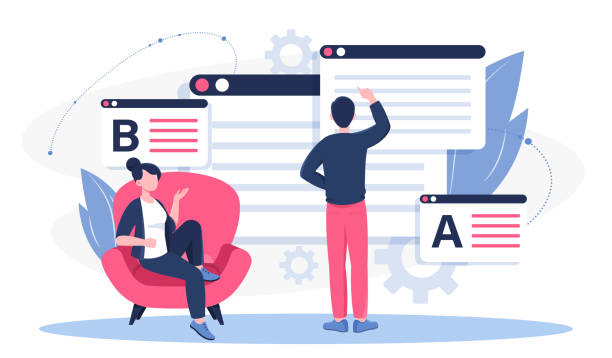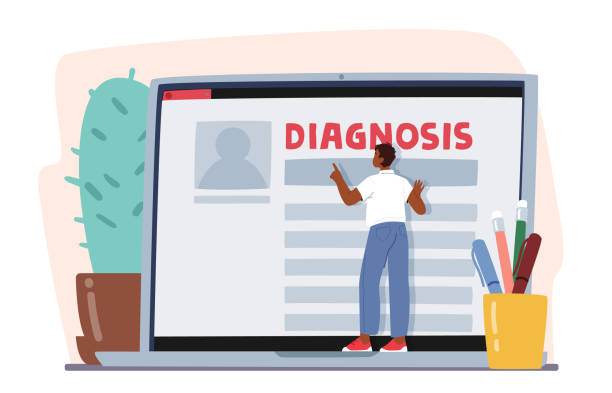The Importance of User-Friendly Website Design in the Digital Age

In today’s fast-paced digital world, having a website is not merely about having an online presence, but about having an effective and useful presence.
This is where the concept of user-friendly website design gains special importance.
A user-friendly website means a site that users can easily interact with, find the information they need, and achieve their goals.
This approach is considered the foundation of any digital success.
User Experience (UX) and User Interface (UI) are two key concepts at the heart of #UserFriendlyWebsiteDesign.
UX addresses all aspects of user interaction with a product or service, while UI focuses on the visual and interactive appearance of a product.
This #educational article aims to unpack the different layers of a user-centric website and show why we should think beyond aesthetics to functionality and ease of use.
A poor design can lead to user confusion, quick site abandonment, and loss of potential customers, whereas a good design increases user retention, conversion rates, and ultimately, business growth.
This topic provides a comprehensive #explanation of the basic and fundamental principles in this field, essential for every online business owner.
Indeed, investing in user-friendly website design is not just an expense, but a smart investment for your digital future.
Does your company’s website perform as befits your brand? In today’s competitive world, your website is your most important online tool. Rasaweb, specializing in professional corporate website design, helps you to:
✅ Build customer credibility and trust
✅ Convert website visitors into customers
⚡ Get a free consultation!
Core Principles of User Experience and User Interface in User-Friendly Website Design

To achieve a user-friendly website design, a deep understanding of User Experience (UX) and User Interface (UI) principles is essential.
UX principles include usability, equity (inclusivity), usefulness, accessibility, desirability, and credibility.
For example, usability means how easily users can accomplish their goals on the site.
Are the menus clear? Are the forms simple? Usefulness means whether your site truly addresses user needs and solves a problem. These specialized aspects are the backbone of any successful website.
In the User Interface (UI) section, the focus is on visual and interactive design.
Using appropriate colors, readable fonts, sufficient white space, and logical arrangement of visual elements all contribute to improving the user experience.
An intuitive UI guides the user without confusing them.
User-friendly website design requires a delicate balance between aesthetics and functionality.
A beautiful but unusable interface quickly discourages the user.
Conversely, a functional but unattractive interface may fail to capture the user’s attention.
Therefore, both UX and UI must work together synergistically to provide an unparalleled user experience.
This is a fundamental guide for any web designer aiming to create a truly effective site.
Continuous practice and updating knowledge in this field are of high importance.
Accessibility and Responsiveness: Pillars of User-Friendly Website Design

In creating a user-friendly website design, two concepts, Accessibility and Responsiveness, play a vital role.
Accessibility means that your website is usable by all individuals, including those with disabilities (such as people with visual, hearing, or motor impairments).
This is not only an ethical responsibility but also important for expanding the audience and reaching a larger market.
Using alternative text for images, maintaining appropriate color contrast, keyboard navigation, and semantic structuring of content are among the elements that help increase accessibility.
Web Content Accessibility Guidelines (WCAG) provide a comprehensive guide in this area.
Responsiveness, or responsive design, refers to the website’s ability to automatically adapt to various screen sizes and resolutions (mobile, tablet, laptop, and desktop).
Given the increasing use of mobile devices to access the internet, having a responsive website is no longer a luxury but a necessity.
Sites that do not display well on different devices create a negative user experience and lose users.
In fact, these two principles are specialized and essential components for any user-friendly website design, and a complete explanation of how to implement them will help you build an inclusive and accessible website.
| Feature | Description | Importance |
|---|---|---|
| Alt Text | Text descriptions for images, for users with visual impairments | Essential |
| Adequate Color Contrast | Ensuring sufficient difference between text and background colors | Essential |
| Keyboard Navigation | Ability to access all elements using the Tab key and other keys | Essential |
| Specified Language | Defining the main language of the page for screen readers | Important |
| Semantic HTML Structure | Using correct tags (h1-h6, p, ul, li) for content organization | Important |
Clear Navigation and Visual Layout in User-Friendly Website Design

Navigation is one of the most fundamental elements in user-friendly website design.
If users cannot easily find what they are looking for, they will quickly leave the site.
A clear, logical, and predictable navigation system helps users move between pages without confusion.
This includes main menus, submenus, breadcrumbs (user’s path), and an efficient search function.
Menus should be named with clear and understandable words, and categories should be logical and intuitive.
Any ambiguity or complexity in this section can severely damage the user experience.
In addition to navigation, the visual layout (Layout) of pages is also very important in user-friendly website design.
The layout should present information hierarchically and digestibly.
Using sufficient white space (Whitespace) around elements helps visually separate content and prevents page clutter.
Furthermore, placing key elements like Call-to-Action buttons in prominent and accessible locations increases conversion rates.
A good layout guides the user’s eye toward important information and facilitates the process of scanning and understanding content.
Guidance on best layout practices, including the use of well-known design patterns like F-shaped or Z-shaped layouts, can help improve the user experience.
These elements are the foundation of a user-centric website design that accompanies the user on their journey through the website and prevents them from getting lost.
Do you have an e-commerce site but your sales are not as expected? Rasaweb solves your problem permanently with professional e-commerce website design!
✅ Significant increase in conversion rates and sales
✅ Unparalleled user experience for your customers
⚡ Click here to get a free consultation with Rasaweb!
Engaging Content and Visual Design in User-Friendly Website Design

Content is king, and this principle also holds true in user-friendly website design.
High-quality, relevant, and engaging content not only attracts users but also keeps them on the site longer.
This content can include informative texts, high-quality images, engaging videos, and clear infographics.
The writing should be fluid, readable, and free of complex jargon, unless the target audience is specialized individuals.
Using headings and subheadings, short paragraphs, and bulleted lists helps with content scannability, enabling users to quickly find the information they need.
Alongside content, the visual design of the website also plays a vital role in creating a user-friendly website design.
Colors, fonts, images, and icons all contribute to creating a specific mood and feel on the website.
Visual design should be consistent with your brand identity and visually reinforce your message.
Using a harmonious color palette, readable fonts, and proper visual hierarchy improves the user’s visual experience.
Images and videos should be optimized for loading to avoid slowing down the site.
The ultimate goal is to create an entertaining and informative visual experience that is both aesthetically pleasing and effectively conveys information.
This interaction between content and design forms the heart of a user-centric website, converting visitors into loyal customers.
Optimizing Performance and Load Speed for a Better User Experience

In today’s world where speed is paramount, website load speed is considered one of the most critical factors in user-friendly website design.
Studies have shown that even a one-second delay in page loading can lead to a significant decrease in conversion rates and an increase in bounce rate.
Today’s users are impatient and expect websites to load quickly.
Therefore, optimizing website performance is an important analytical and news-worthy aspect in the web domain, with new methods being introduced daily.
There are numerous solutions to increase load speed.
Image optimization by compression and using appropriate formats (like WebP) is one of the first steps.
Minification of code in CSS, JavaScript, and HTML files, removing extra code and comments, also helps reduce file sizes.
Using Browser Caching to store static elements of the site during the user’s first visit makes the site load faster on subsequent visits.
Using Content Delivery Networks (CDNs) to serve content from the closest server to the user also significantly increases speed.
Moreover, choosing a powerful and optimized hosting is itself one of the most crucial factors in site speed.
These technical measures, though they may seem complex, are absolutely essential for ensuring a user-friendly website design and competitiveness in today’s digital market.
Paying attention to these aspects means optimizing for the user and providing a seamless experience.
Usability Testing and User Feedback: A Crucial Step in User-Friendly Website Design

After implementing a user-friendly website design, the work is not over.
Instead, the crucial stage of usability testing and gathering feedback from real users begins.
Without this stage, you cannot be sure that your design truly meets user needs and where its potential flaws lie.
Usability testing allows you to identify the site’s strengths and weaknesses by observing user behavior.
This analytical process is a fundamental step in continuously improving the user experience.
There are various methods for conducting usability testing: from A/B testing, where two different versions of a page are shown to users to determine the best performance, to user interviews and surveys for gathering qualitative insights.
Heatmaps and Session Recordings are also powerful tools that monitor precise user behavior, showing click points, mouse movements, and scrolls.
This information helps designers understand how users interact with the site and what obstacles they encounter.
Applying these guidelines and using real data helps you continuously improve your user-friendly website design and ensure that your site always performs at its best.
This cyclical process ensures that a user-centric website is always evolving.
| Test Method | Brief Description | Main Advantage |
|---|---|---|
| A/B Testing | Comparing two versions of a page to determine better performance | Accurate quantitative data |
| Usability Testing | Observing real users performing specific tasks on the site | Identifying UX obstacles |
| Surveys and Questionnaires | Collecting direct feedback from users about their experience | Qualitative and extensive insights |
| Heatmaps | Visual representation of user clicks, mouse movements, and scrolls | Visual user behavior analysis |
| In-depth Interviews | Conversations with users to deeply understand their motivations and problems | Identifying hidden needs |
The Impact of User-Friendly Website Design on SEO and Online Visibility

The relationship between user-friendly website design and Search Engine Optimization (SEO) is a symbiotic one.
Many factors that improve a site for users also help its ranking in search engines.
Search engines like Google aim to provide the best possible experience for their users, so websites with a strong user experience typically rank higher.
This is an important explanation of how UX and SEO are linked.
Factors such as low bounce rate, user dwell time on the site, and high conversion rate, all indicators of a user-friendly website design, directly impact the site’s SEO.
When users are satisfied with your site and spend more time on it, search engines evaluate this as a positive signal and assume your content is valuable and relevant.
Furthermore, site load speed, mentioned earlier, is a direct ranking factor for Google.
Responsive and accessible websites are also preferred by search engines.
Therefore, investing in user-centric website design not only keeps customers satisfied but also helps increase your visibility in search results.
This specialized and comprehensive approach is the foundation of sustainable success in the online world and doubles the importance of user optimization.
Did you know your company’s website is the first point of contact for 75% of potential customers?
Your website is the face of your brand. With **Rasaweb**’s corporate website design services, build an online presence that earns customer trust.
✅ Create a professional and lasting image for your brand
✅ Attract target customers and increase online credibility
⚡ Get a free consultation from **Rasaweb** experts!
Common Mistakes and Best Practices in User-Friendly Website Design

In the process of user-friendly website design, designers and developers may make common mistakes that can harm the user experience.
Recognizing these mistakes and being familiar with best practices is a crucial step towards creating a successful website.
Have you ever encountered a site that was difficult to navigate? Or had a cluttered design that was hard on the eyes? These are examples of common errors that challenge the user experience and, in a way, create a questionable content for users.
Common mistakes include: complex and non-intuitive navigation, using unreadable fonts or small text sizes, cluttered and disorganized design with excessive content, neglecting responsive design for mobile devices, and slow load speed.
Also, failing to provide proper feedback to the user (e.g., after form submission) and using unpredictable interactive elements are among the things that confuse users.
To avoid these mistakes, best practices include adhering to simplicity in design, using clear visual hierarchy, ensuring mobile compatibility, continuous site speed optimization, and conducting regular usability tests.
A practical and educational guide in this area is to always put yourself in the user’s shoes and ask: Can I easily do this? Is this page clear to me? This approach transforms user-friendly website design from a concept into a reality.
Future Trends and the Evolution Outlook of User-Friendly Website Design

The digital world is constantly evolving, and user-friendly website design is no exception.
New trends are emerging that shape the future of our interactions with websites.
One of the most important of these trends is Artificial Intelligence (AI) in user experience.
AI can provide highly personalized experiences by analyzing user behavior; from recommending relevant content to smart chatbots that offer instant support.
This is a very hot news and analytical area in the web industry.
Voice User Interfaces (VUIs) are also gaining popularity, especially with the proliferation of voice assistants like Siri and Alexa.
Designing for voice interaction requires a different approach that focuses less on visual aspects and more on natural conversation.
Microinteractions, which are small details like button animations or haptic feedback, also play an important role in creating a pleasant experience and user-friendly website design.
Augmented Reality (AR) and Virtual Reality (VR) are also entering the web space and can offer completely immersive and new experiences.
However, despite all these technological advancements, one fundamental principle will always remain: user-centricity.
No matter how much technology advances, the ultimate goal should always be to improve users’ lives and interactions.
User-friendly website design in the future will also focus on a deep understanding of human needs and expectations, and will always seek new ways to provide an unparalleled experience for users.
Frequently Asked Questions
And other services of Rasa Web Advertising Agency in the field of advertising
Smart Link Building: Professional optimization for campaign management using attractive UI design.
Smart Digital Advertising: An effective tool for analyzing customer behavior with the help of real data.
Smart Social Media: Revolutionize customer behavior analysis with the help of smart data analysis.
Smart UI/UX: A new service to increase online growth through SEO-driven content strategy.
Smart Advertorials: A dedicated service for increasing website traffic based on real data.
And more than hundreds of other services in the field of internet advertising, advertising consulting, and organizational solutions
Internet Advertising | Advertising Strategy | Advertorials
Resources
How to Design a User-Friendly Website?Secrets of Online Business SuccessThe Importance of User Experience in Web DesignPrinciples of Website Design for Customer Attraction
🚀 With Rasaweb Afarin, your business soars in the digital world! By offering services such as secure website design, Search Engine Optimization (SEO), and targeted advertising campaigns, we create a powerful and lasting presence for your brand.
📍 Tehran, Mirdamad Street, next to Bank Markazi, Southern Kazeroon Alley, Ramin Alley, No. 6



